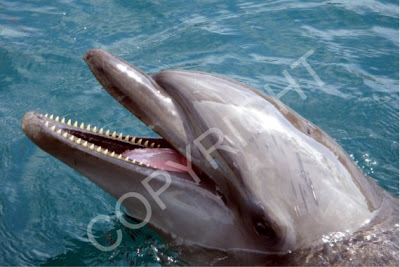In the year 2000, March was named dolphin awareness month in Galveston, Texas...

In celebration of this month, here are some fun facts about dolphins...
Fact: Like a bat, dolphins use echolocation to navigate and hunt, bouncing high-pitched sounds off of objects, and listening for the echoes. MIT Sea Grant
Fact: Fish and squid are the diet of the common dolphin, where the dolphins have been seen hunting and working together to herd fish into tight balls. American Cetacean Society
Fact: Baby dolphins are sucked forward by the motion of their swimming mothers – giving them a needed assist – when they position themselves to the right and behind their mothers. Discovery Channel News
Fact: Dolphins sleep with one half of their brain plus one eye closed, then switching to the other side of the brain and the other eye closed during other parts of the day –slowing down everything inside their bodies and moving very little. MIT Sea Grant
Fact: Dolphins can recognize their own reflection in a mirror. Nova

Here is an article providing a few simple highlights of dolphins’ cognitive ability and language skills. I hope you find it interesting and perhaps even learn something new. To begin with I noted the behaviorist’s philosophy.
The behaviorist’s movement in science has a long history and was still growing strong in the 1970’s. At the American Philosophical Association in 1973, Norman Malcolm stated in his presidential address, “The relationship between language and thought must be…so close that it is really senseless to conjecture that people may not have thoughts, and also really senseless to conjecture that animals may have thoughts.”
Basically this means that if animals can’t talk, they can’t think.
The behaviorists further believed that “animals are automatons, responding mindlessly to stimuli”, as noted by Irene Pepperberg, a scientist who specializes in animal cognition, in her book “Alex and Me”.

However, those interested in animal communication and cognition, know that this is simply not true. Dolphins are among the most intelligent animals and have a brain that is so large compared to its’ body size, it is second only to humans.
Dolphins, or cetaceans (the scientific name for whales) use their incredible brain to plan, organize, and strategize in catching food. Living in a group called a pod, bottlenose dolphins work together to catch fish. They will encircle a school of fish and then take turns charging the school to feed. Sometimes, dolphins will use their tail flukes to hit larger fish into the air, stunning them so that they may be more easily caught.
What enables these skilled and intelligent creatures to hunt as a pod is communication. Dolphins have a complex language that eludes humans. Their dialogue includes a series of whistles, clicks, barks, squawks, and rasps. Dolphins may also use a more direct approach to signal others by jumping straight out of the water and landing with a large splash.

Dolphins also possess a super power that humans don’t have: echolocation. They can produce a series of 2,000 clicks per second which will hit an object and bounce back to them thus revealing the exact location of the object. Not only can dolphins scan objects with their sonar, they can combine it with their vision to identify objects as well. They use these special skills to hunt and swim at night.
Some of the most current research has also discovered that dolphins use communication, namely whistles, to “name” themselves, which was first proposed in a scientific study as recently as 1991. Because dolphins, especially bottlenose dolphins, live in large groups with complex social interactions, they need a way to know and find each other in the murky, visibly-poor, and dark nighttime waters of the ocean.

In one study, it was learned that dolphins responded to signature whistles or “names” of close relatives and “friends”, but ignored those that they did not know.
Young dolphins make up their own signature whistles from those of adult dolphins.
This skill to name requires “vocal learning” which is a relatively rare skill and has been found in humans, elephants, dolphins, and certain birds such as parrots, along with a few other animals.
In order to know where we are going as a society, it is important to know where we've been. Many researchers and scientists are leading the way into the realm of animal cognition, thus raising their status in the human world, which, I think, is important to us all.

http://www.tmmsn.org/news/dolphin_awareness_month.htm
http://news.nationalgeographic.com/news/2006/05/060508_dolphins_2.html
“Alex and Me” by Irene Pepperberg
“Dolphins” by Seymour Simon




















That was REALLY interesting! Who knows...they could be talking about us behind our backs! Love the way they name each other. Great article!
ReplyDeleteThanks!
ReplyDeleteWhat a fascinating article, Heather !
ReplyDeleteI'm going to rewatch the video :)
THANKS so much,
xo